|
Hide all answers
Hide all answers
View all answers
View all answers
Print
Try the Quiz
| Compare the two quantities and choose the best answer from four choices given. |
1. x and y are both positive and x/y > 5
Quantity A = 0.2x Quantity B = y
• Quantity A is greater
• Quantity B is greater
• The two quantities are equal
• The relationship cannot be determined from the information given
Answer: Quantity A is greaterNow x > 5y.
Dividing both sides of this inequality by 5, we get 0.2x > y.
2. John travels at 60 mph and James travels at 80 mph.
Quantity A = Time for John to cover 20 miles
Quantity B = Time for James to cover 40 miles
• Quantity A is greater
• Quantity B is greater
• The two quantities are equal
• The relationship cannot be determined from the information given
Answer: Quantity B is greaterTime = Distance / Speed
Time taken by John = 20/60 = 1/3 hour.
Time taken by James = 40/80 = 1/2 hour.
So Quantity B (time taken by James) is greater.
3.

Diagram is illustrative and is not drawn to scale.
Quantity A = Measure of angle 1 + Measure of angle 2 + Measure of angle 4
Quantity B = 180o
• Quantity A is greater
• Quantity B is greater
• The two quantities are equal
• The relationship cannot be determined from the information given
Answer: The two quantities are equalIn the figure, angles 3 and 4 are vertically opposite angles and are equal.
Also the sum of the three angles of a triangle is 180o.
Hence angle 1 + angle 2 + angle 4 = 180o.
4.
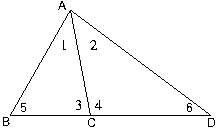
Diagram is illustrative and is not drawn to scale.
Quantity A = Measure of angle 1 + Measure of angle 3
Quantity B = Measure of angle 2 + Measure of angle 4
• Quantity A is greater
• Quantity B is greater
• The two quantities are equal
• The relationship cannot be determined from the information given
Answer: The relationship cannot be determined from the information givenQuantity A = 180o - angle 5 and Quantity B = 180o - angle 6.
Now the values of A and B depend on angles 5 and 6 about which nothing is given.
Hence the relationship is indeterminate.
5.

Diagram is illustrative and is not drawn to scale.
Quantity A = Measure of angle 2 + Measure of angle 3
Quantity B = 180o
• Quantity A is greater
• Quantity B is greater
• The two quantities are equal
• The relationship cannot be determined from the information given
Answer: The two quantities are equalAngles 2 and 3 lie on a straight line and are supplementary angles.
Hence their sum = 180o.
6.
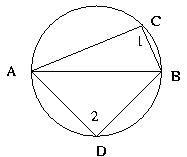
Diagram is illustrative and is not drawn to scale.
AB is the diameter of the circle.
Quantity A = Measure of angle 1
Quantity B = Measure of angle 2
• Quantity A is greater
• Quantity B is greater
• The two quantities are equal
• The relationship cannot be determined from the information given
Answer: The two quantities are equalAngle subtended by the diameter on the circumference = 90o.
So angle 1 = angle 2 = 90o.
7.
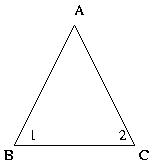
Diagram is illustrative and is not drawn to scale.
Given AB = AC and angle BAC = 60o
Quantity A = Length of side AB
Quantity B = Length of side BC
• Quantity A is greater
• Quantity B is greater
• The two quantities are equal
• The relationship cannot be determined from the information given
Answer: The two quantities are equalAs sides AB and AC are of the same length, angles 1 and 2 must be equal.
The angles of a triangle add up to 180o.
Since angle A = 60o, the other 2 angles must also be 60o.
This is therefore an equilateral triangle. So AB = BC.
8. 0 < -x < 10 11 < -y < 20
Quantity A = x Quantity B = y
• Quantity A is greater
• Quantity B is greater
• The two quantities are equal
• The relationship cannot be determined from the information given
Answer: Quantity A is greaterx lies between -10 and 0, while y lies between -20 and -11.
Hence x is always greater that y.
9. Quantity A = 29 Quantity B = 92
• Quantity A is greater
• Quantity B is greater
• The two quantities are equal
• The relationship cannot be determined from the information given
Answer: Quantity A is greater29 can be written as 2 x 28 = 2 x 162, which is greater than 92.
10.

Diagram is illustrative and is not drawn to scale.
Given angles 1 and 2 are equal,
length of side AB = x, length of side BC = y, length of side AC = z.
Quantity A = x + y
Quantity B = y + z
• Quantity A is greater
• Quantity B is greater
• The two quantities are equal
• The relationship cannot be determined from the information given
Answer: The two quantities are equalGiven angles 1 and 2 are equal, the triangle is isosceles and x = z.
Adding y to both sides of the equation, we get x + y = z + y
11. y2 = 36
Quantity A = y Quantity B = 6
• Quantity A is greater
• Quantity B is greater
• The two quantities are equal
• The relationship cannot be determined from the information given
Answer: The relationship cannot be determined from the information givenIf y2 = 36, then y can be either 6 or -6.
So Quantity A and Quantity B may not always be equal.
The relationship is indeterminate.
12.

Diagram is illustrative and is not drawn to scale.
In triangle ABC, angle A = 60o and AB = AC.
Quantity A = Measure of angle 1 + Measure of angle 2
Quantity B = 120o
• Quantity A is greater
• Quantity B is greater
• The two quantities are equal
• The relationship cannot be determined from the information given
Answer: The two quantities are equalIf angle A = 60o, then angle 1 + angle 2 = 180o - 60o = 120o.
13.
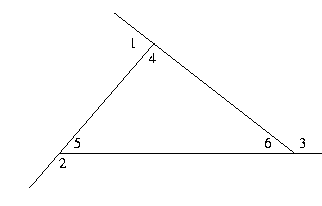
Diagram is illustrative and is not drawn to scale.
Quantity A = Measure of angle 3 - Measure of angle 2
Quantity B = Measure of angle 5 - Measure of angle 6
• Quantity A is greater
• Quantity B is greater
• The two quantities are equal
• The relationship cannot be determined from the information given
Answer: The two quantities are equalFor the given figure, we have the following relations:
angle 3 = 180o - angle 6 = angle 4 + angle 5
angle 2 = 180o - angle 5 = angle 4 + angle 6
Subtracting the two equations, we have
angle 3 - angle 2 = angle 5 - angle 6.
14.
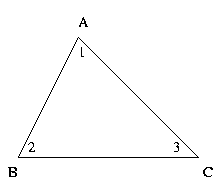
Diagram is illustrative and is not drawn to scale.
In triangle ABC, AB = AC and measure of angle 1 = 100o.
Quantity A = Measure of angle 2 + Measure of angle 3
Quantity B = 90o
• Quantity A is greater
• Quantity B is greater
• The two quantities are equal
• The relationship cannot be determined from the information given
Answer: Quantity B is greaterGiven angle 1 = 100o.
angle 2 + angle 3 = 180oo = 80o.
Hence Quantity B is greater.
15.
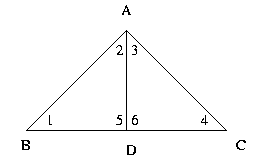
Diagram is illustrative and is not drawn to scale.
Consider an isosceles triangle ABC right-angled at A,
with a perpendicular dropped from A on to BC at point D.
Quantity A = Length of side BD
Quantity B = Length of side DC
• Quantity A is greater
• Quantity B is greater
• The two quantities are equal
• The relationship cannot be determined from the information given
Answer: The two quantities are equalThe perpendicular between the two equal sides of an isosceles triangle bisects the opposite side. So BD = DC.
16. The calorific value of 5 tumblers of orange juice with 4 spoons of sugar equals the calorific value of 3 tumblers of orange juice with 6 spoons of sugar.
Quantity A = calorific value of 1 tumbler of orange juice
Quantity B = calorific value of 1 spoon of sugar
• Quantity A is greater
• Quantity B is greater
• The two quantities are equal
• The relationship cannot be determined from the information given
Answer: The two quantities are equalThe equation 5A + 4B = 3A + 6B represents the given condition.
On simplifying, we get A = B.
17. x < 0
Quantity A = x2 Quantity B = x3
• Quantity A is greater
• Quantity B is greater
• The two quantities are equal
• The relationship cannot be determined from the information given
Answer: Quantity A is greaterIf x is negative, its square will always be positive and cube will be negative.
So Quantity A is greater.
18. The chance of an arrow striking the Bull's Eye is 0.07%.
An archer fires 10,000 arrows.
Quantity A = Number of arrows striking the Bull's Eye
Quantity B = 70
• Quantity A is greater
• Quantity B is greater
• The two quantities are equal
• The relationship cannot be determined from the information given
Answer: Quantity B is greater0.07% of 10000 = (0.07/100) x 10000 = 7. So Quantity B is greater.
19. The sum of three consecutive numbers is 150.
Quantity A = largest number of the three Quantity B = 50
• Quantity A is greater
• Quantity B is greater
• The two quantities are equal
• The relationship cannot be determined from the information given
Answer: Quantity A is greaterLet the three consecutive numbers be n-1, n and n+1.
Their sum = 3n = 150. So n = 50.
The numbers therefore are 49, 50 and 51.
The largest number is 51. Hence Quantity A is greater.
20. Quantity A = (x + y)2 Quantity B = x2 + y2
• Quantity A is greater
• Quantity B is greater
• The two quantities are equal
• The relationship cannot be determined from the information given
Answer: The relationship cannot be determined from the information givenNow (x + y)2 = x2 + y2+ 2xy.
Various cases arise depending on whether xy is positive, negative or zero.
As this information is not given, the relationship is indeterminate.
Try the Quiz : GRE Test Prep : Quantitative Comparison V
|